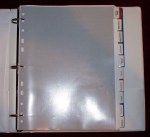I’ve referred a couple times to my records notebook. In a three-ring binder, I have divider tabs for different sections. Here’s how I do it:

Appointment Notes
The first section holds appointment notes. My doctors keep track of what takes place at appointments; so do I. In the beginning, I just used notebook paper. Eventually I created my own form to standardize the information. It’s kept on my computer, so is very easy to quickly complete and print out prior to every appointment.
Before an appointment, I write details (in the notes section) that I want to be sure to mention to the doctor, as well as all the questions that I want to ask. I leave plenty of space to jot down answers. When I don’t have enough space, it means that I’m trying to cram too much into one appointment.
Some people have a separate divider tab for every doctor they see. It probably depends on how many doctors you have, and how frequently you see them. So far, it’s working for me to file my appointment notes together, in reverse chronological order (most recent is on top).
One other thing I do. This is just me trying to keep track of everything, and might be considered overly compulsive by some. Okay, by everyone. Maybe I shouldn’t share this here. I take a camera to my appointments and photograph every piece of paper that the doctor gives me. This provides a record for me of exactly what the prescription/referral/lab order says. Back home, I print those pix on the back of my appointment notes. When I thought the pharmacy made a mistake on my prescription, I was able to look at my notebook to check before bringing it to their attention (I was right; they messed up). When the lab sent my blood all over the country for specialized tests, I had a place to check and see if I should be expecting even more envelopes full of results. When I forget to write down all my prescription information, this gives me a reliable place to look.
Medication
Three things go behind this tab. The first page is a spreadsheet showing prescriptions filled during the current calendar year (when the year is over, the page goes into our tax file). Columns are patient, prescriber, medication/purpose, pharmacy (ideally always the same, but occasionally one will be out of stock and I’ll go elsewhere for a one-time fill), out-of-pocket cost, what it would have cost without insurance (just because I’m curious), and a column to mark off when I submit the receipt to our flexible spending (125) plan (because it makes a difference on our taxes at the end of the year).
The second page is a running list of meds that I’ve tried, and the result. Columns are: date, medication/dose, purpose, duration (short term or ongoing, date discontinued, etc.), and comments. When I changed rheumatologists, this list was very helpful in being able to say the exact date that I started/stopped a variety of prescriptions. I’m also told that it will be useful documentation if I should ever need to try a biologic.
The third thing that goes behind this tab is all the drug information that I’ve found as I’ve learned about RA. Some of the information is discussion of DMARDs, other pages are specific to certain drugs. The six-page methotrexate printout that my rheumatologist gave me is filed here. Since my rheumy has now mentioned a biologic at two different appointments, I’ll probably start researching those, too.
Lab Results
Every time a med tech sticks a needle in my arm, I request a copy of the lab results. The pages are filed here. These, too, are in reverse chronological order, making it very easy to locate anything I’ve ever needed to look up. This section also has a spreadsheet tracking fluctuations of my routinely ordered labs.
Other Test Results
This divider tab is where I file reports from tests other than lab work: MRI, CT, EMG, biopsy, mammogram, heart monitor, x-rays
PT
My physical therapist gave me printouts to help me remember the exercises he assigned. I filed the pages behind this tab (and made photocopies to pin to the wall where I actually do the exercises).
Maps
Seriously. Laugh if you wish, but I have no sense of direction. At all. I need a way to reduce my chances of getting lost. Since I always take my notebook to appointments, the notebook is a good place to keep maps. There is a printout here of the mapquest route between my house and the office of every doctor I see. One page per physician, with map on one side of the page; clinic name, doctor’s name, address, telephone number, fax number, and driving directions on the reverse.
My husband is considering getting me a GPS for Christmas, but until that happens, the map section of my notebook is tremendously valuable.
Kids
The final section is for my kids. I don’t always bother with a full appointment-notes form, but I do make sure that I document any time I take one of the kids to the doctor.


Pingback: Database Update « ∞ itis
Pingback: Detective Work « ∞ itis